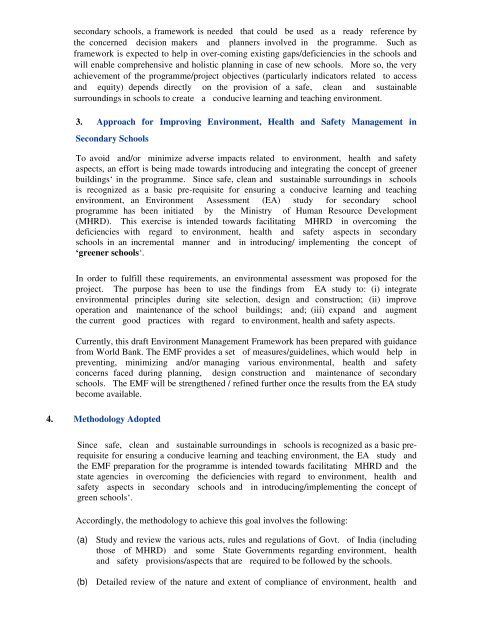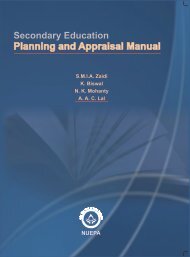Download File
Download File
Download File
You also want an ePaper? Increase the reach of your titles
YUMPU automatically turns print PDFs into web optimized ePapers that Google loves.
secondary schools, a framework is needed that could be used as a ready reference by<br />
the concerned decision makers and planners involved in the programme. Such as<br />
framework is expected to help in over-coming existing gaps/deficiencies in the schools and<br />
will enable comprehensive and holistic planning in case of new schools. More so, the very<br />
achievement of the programme/project objectives (particularly indicators related to access<br />
and equity) depends directly on the provision of a safe, clean and sustainable<br />
surroundings in schools to create a conducive learning and teaching environment.<br />
3. Approach for Improving Environment, Health and Safety Management in<br />
Secondary Schools<br />
To avoid and/or minimize adverse impacts related to environment, health and safety<br />
aspects, an effort is being made towards introducing and integrating the concept of greener<br />
buildings‘ in the programme. Since safe, clean and sustainable surroundings in schools<br />
is recognized as a basic pre-requisite for ensuring a conducive learning and teaching<br />
environment, an Environment Assessment (EA) study for secondary school<br />
programme has been initiated by the Ministry of Human Resource Development<br />
(MHRD). This exercise is intended towards facilitating MHRD in overcoming the<br />
deficiencies with regard to environment, health and safety aspects in secondary<br />
schools in an incremental manner and in introducing/ implementing the concept of<br />
‘greener schools‘.<br />
In order to fulfill these requirements, an environmental assessment was proposed for the<br />
project. The purpose has been to use the findings from EA study to: (i) integrate<br />
environmental principles during site selection, design and construction; (ii) improve<br />
operation and maintenance of the school buildings; and; (iii) expand and augment<br />
the current good practices with regard to environment, health and safety aspects.<br />
Currently, this draft Environment Management Framework has been prepared with guidance<br />
from World Bank. The EMF provides a set of measures/guidelines, which would help in<br />
preventing, minimizing and/or managing various environmental, health and safety<br />
concerns faced during planning, design construction and maintenance of secondary<br />
schools. The EMF will be strengthened / refined further once the results from the EA study<br />
become available.<br />
4. Methodology Adopted<br />
Since safe, clean and sustainable surroundings in schools is recognized as a basic prerequisite<br />
for ensuring a conducive learning and teaching environment, the EA study and<br />
the EMF preparation for the programme is intended towards facilitating MHRD and the<br />
state agencies in overcoming the deficiencies with regard to environment, health and<br />
safety aspects in secondary schools and in introducing/implementing the concept of<br />
green schools‘.<br />
Accordingly, the methodology to achieve this goal involves the following:<br />
(a) Study and review the various acts, rules and regulations of Govt. of India (including<br />
those of MHRD) and some State Governments regarding environment, health<br />
and safety provisions/aspects that are required to be followed by the schools.<br />
(b) Detailed review of the nature and extent of compliance of environment, health and




